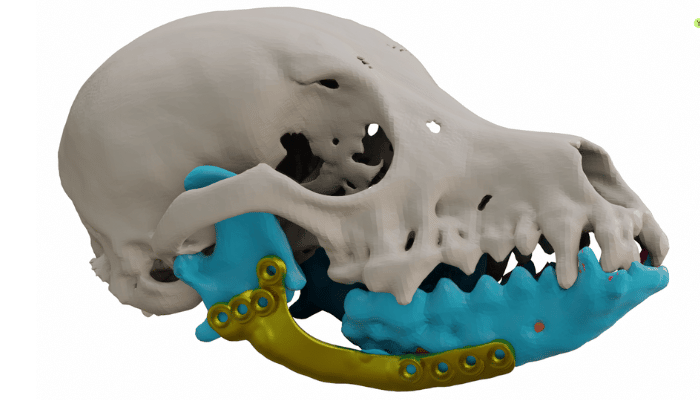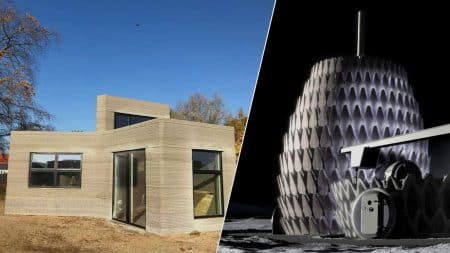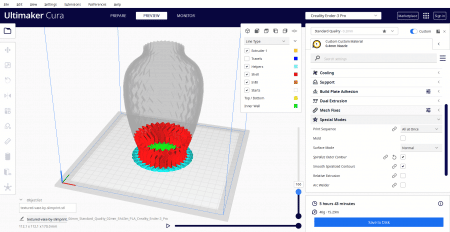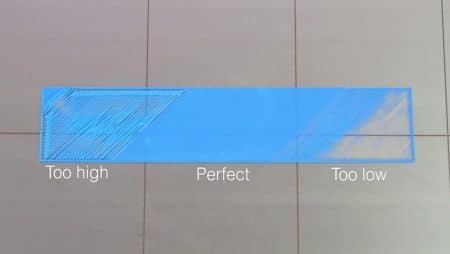Table of Contents
We are obviously referring to animals, specifically pets, who hold a special place in our hearts and occasionally even sleep on our couches. They are regarded as man’s best friend. Humans and animals have coexisted for all of recorded history, and this coexistence is still present today. Dogs, cats, fish, and birds are the most common species, and there are significantly more animals per household in 2016 than there were in 2020. In 2016, 76.8 million dogs and 58.4 million cats were adopted worldwide. In just four years, this number increased to 83.7 million dogs and 60 million cats. The Corona Pandemic that started at that time and the ensuing global lockdowns can be partly blamed for this rise, as home office arrangements allowed employees in particular to spend more time with pets. However, additive manufacturing has made it possible to develop all the treatments and applications required for veterinary medicine for our animal friends, in addition to enabling the growth in the number of pets.
It is widely known that additive manufacturing has advantages in a variety of fields, including veterinary medicine. It is simple to understand why additive manufacturing is being used in veterinary medicine given that it represents a sizable and expanding portion of the economy. More than 120,000 veterinarians are currently working in the field in the United States alone, helping animals with a range of illnesses and conditions. Therefore, it should come as no surprise that as the number of pets rises, so does the industry’s overall value. The global market for veterinary services is predicted to reach $114.4 billion by 2028, per a study by Grand View Research, Inc. Now, however, commercial companies are diligently developing new applications so that they too will be able to help animals, in addition to veterinarians, who are using 3D printing to care for the health of our animals. But what are the 3D printing industry’s constraints and opportunities in this field, as well as the typical workflow and application?

The Use of Additive Manufacturing by Veterinarians
No pet owner enjoys having to bring their animal companion to the closest vet clinic. However, in addition to unpleasant health surprises, there are frequently other horror stories, such as exorbitant costs, lengthy wait times for orthoses or prostheses (among other necessary treatments), or simply the fact that veterinary products cannot be customized for a particular animal. Thankfully, many of these problems can be solved with 3D printing. Additionally, new material developments have made it possible to create more materials to meet the sector’s various needs. As a result, the materials make it possible to enjoy a variety of advantages, including lower costs, shorter wait times, and a high level of customization. Innovative methods can, however, also influence and streamline each step an animal patient takes when visiting a veterinarian who employs additive manufacturing. Typically, veterinarians who use AM use materials like PEEK, PEKK, and, for surgical activities, dental plastics like nylon, PLA, and PVA, for example.
Concrete Veterinary Medical Applications
It is first necessary to comprehend the conventional approaches in order to go into greater detail about how additive manufacturing is being used in veterinary medicine. For instance, many of the traditional methods of treatment used by veterinarians are oftentimes even more closely aligned with human medicine. Having said that, it is important to keep in mind that some treatment options are simply not viable despite having partially identical DNA and other physical characteristics. The scan is frequently done before an operation or prosthesis can be made. The first difficulties already exist in this situation, and this is where we can see the advantages of using 3D technologies, as some animals cannot fit into a standard veterinary CT scanner because of their conditions and other issues (notably related to being able to lie still).
Sedation, or the administration of tranquilizers to calm the central nervous system’s functions, is an option, but it is also expensive and time-consuming. With 3D scanning, the scanning can be done quickly, which eliminates the need for sedation, and it can also be done with a high level of accuracy. Unlike traditional CT scanning machines, which would have already failed with dangerous animals like an alligator or animals that live in water, the portable nature of this device makes it possible to scan any type of animal without any issues.
Mister Stubbs the alligator, who is arguably the best example of what is possible with 3D scanning, demonstrates this. The alligator was missing its tail when it was discovered in a semi-truck in 2013. Although it may seem unimportant, an alligator’s tail is actually used for more than just locomotion and steering in the water. The root of the tail is where fats are stored, which significantly improves the animal’s health. Midwestern University in Glendale, Arizona, scanned the tail of a recently deceased alligator using an Artec 3D scanner to assist Mr. Stubbs. The team was able to create a new tail for Mister Stubbs with the help of 3D scanning, which was able to capture all the details of the original tail even though modifications to the exact size for Mister Stubbs were required.

Applications Can Be Customized With AM
When it comes to treating animals, veterinarians and animal hospitals can use additive manufacturing to achieve a wide range of active benefits. To name a few applications, it can be used to create custom models appropriate for pre-surgical needs as well as prosthetics, orthotics, implants, and dental components. The advantages are obvious given that there are an immeasurably greater number of variables to take into account due to various biological conditions and requirements of various animal species. If you compare a fully grown Newfoundland with a dachshund, it is more than obvious that the individualization of treatment is more than necessary. For example, the anatomy of a dog breed varies greatly from breed to breed.
Veterinary medicine is making extensive use of 3D-printed orthoses and prostheses, which can last up to five years before needing to be replaced. The splints, which are fastened to the body, act as an orthopedic aid to relieve, stabilize, or correct problems with joints, bones, or even muscles. A 3D printed prosthetic for a three-month-old cat with a rare congenital deformity of the chest wall is one notable instance.
Dr. Matteo Zanfabro, a veterinarian, turned to 3D printing to help treat this sometimes fatal deformity in cats. The PETG splint, which was created using the Ultimaker S3 and 3D-printed, allowed for not only individual adaptation to the kitten’s size and deformity but also consideration of the animal’s growth. The splint was padded and then closed with surgical wires to provide the required stabilization. And in this case, 3D printing was successful because the young cat experienced no further movement intolerances after wearing the additively manufactured splint.

That is not all, though. The advantages of additive manufacturing in the field of veterinary orthodontics have been a topic of study for a group of researchers from the Slovak University of Technology in Koice. They gave an example of what could be done with additive manufacturing using a 15-month-old Labrador dog who lost a tooth necessary for eating while playing. A unique solution was required because this tooth would not regrow and was also essential to preventing malnutrition. The same tooth that was still present in the young dog’s jaw was scanned in order to use this scan to create a metal 3D-printed implant. AM was chosen in this instance because it allowed for precise scanning while also requiring extremely accurate printing to ensure that the newly created tooth fit perfectly into the gap left by the previous tooth. The Labrador’s additively manufactured tooth was even harder and more resilient than his natural teeth after a regeneration phase.
Dr. Johnny Uday, a veterinarian who has been using AM for five years, discusses dental issues in animals and offers some additional potential difficulties: “Dental issues are so prevalent and cause so much damage to pets’ jaws that they fracture with bone lysis (large holes). However, “standard” plates may be too big or bulky and do more harm than good because dogs come in a variety of sizes. In order to have the perfect fit and size, personalized plates can be created using this technology. The drill holes can also be planned to avoid damaging tooth roots, vascular bundles, nerves, the lymphatic system, and other crucial structures that are required for normal function and proper healing.”

Furthermore, the development of surgical and anatomical models is a good application for additive manufacturing in veterinary medicine. In this situation, surgical models specifically aid veterinarians in achieving better surgical outcomes while also significantly reducing surgical time. These are specifically 3D-printed templates that replicate the corresponding animal patient’s precise cutting planes and holes, enabling surgeons to train on them beforehand. This is appropriate for orthopedic injuries like cruciate ligament tears or even congenital limb issues, in addition to difficult and uncommon operations. Veterinarians can also get a lot of assistance from the anatomical models, which can be further divided into acupuncture, organ, skeletal, and even exercise models. These three-dimensional models, however, are useful for learning and research and benefit not only veterinarians but also students and aspiring veterinarians.
When additive manufacturing is used in veterinary medicine, dogs, cats, but also chickens or cows, benefit primarily. Small animals like hamsters, frogs, or chihuahuas make this more difficult. Dr. Johnny Uday explains to us that this is due to the fact that small animals have anatomy that makes the development of incision guides and implants much more difficult than with large animals. But mastering the subject matter itself is probably the biggest obstacle to integrating AM into the workflow. Dr. Johnny Uday emphasizes the significance of having various software programs and, specifically, biomaterials readily available for 3D printing.
Additive Manufacturing is being used by businesses to help animals.
While many veterinarians already benefit from additive manufacturing, businesses have also discovered huge potential in this field. As a result, more businesses, including Think3DDD, PlayVet, CABIOMEDE, DiveDesign, and even Formlabs and Artec3D, to name a few, are using additive manufacturing in the veterinary industry. In this case, the primary educational background that distinguishes the activities of veterinarians and businesses regarding AM is. While most of the employees at these firms have engineering degrees, veterinarians, of course, have veterinary medicine degrees. Additionally, these have different histories: while businesses produce and market these goods, they have also established a market for their own services and product performance. Veterinarians, on the other hand, use AM to work more productively, to enhance their workflow, and to use AM as a whole. Nevertheless, despite taking a different educational route, the objectives are the same: using additive manufacturing to shorten or simplify the lives of animals.
Berlin-based Tino Jacobi, who founded Think3DDD, explains that the close relationship between the two parties is a result of the extensive customization: “We work closely with the treating veterinarians because of this. Therefore, using guidance from the veterinarians, we create a suitable orthosis or prosthesis, and the veterinarian oversees the course of treatment.” Nevertheless, a sizable number of veterinarians continue to distance themselves from the use of additive manufacturing, according to Alexander Then, owner of NordicVet3D. He explains, outlining the benefits, “I can’t see any reason other than economic why they shouldn’t be used. “We could, for instance, determine which screws and plates would be best in each particular situation. This reduces the possibility of failure or the requirement for additional surgery, both of which are linked to higher mortality and morbidity rates. It has also been demonstrated to decrease surgical time and, consequently, procedure costs.”
The first step in the process, in terms of the technologies and materials used, is 3D scanning, which can even be completed on a smartphone thanks to scanning apps. Software is used to create the digital image of, say, a prosthesis or orthosis after the scan has been completed—either at the company’s location or the veterinarian’s. This can be directly worn after 3D printing and post-processing. Alexander Then goes on to say that the use of FDM/FFF technology allows for the use of “many types of thermoplastic polyurethane plastics (TPU) with different thicknesses, polypropylene (PP), polytene terephthalate (PET), and others.”

Veterinary Medicine’s Additive Manufacturing Restrictions
There are still restrictions in this area of application, even though the advantages of using additive manufacturing in veterinary medicine far outweigh the drawbacks and difficulties. Even though there is already a huge variety of materials that can be used for animal implants, there are still very few biocompatible materials that can also be sterilized. One of the main issues with implants made using additive manufacturing is the development of biofilm. This type of bacterial association, or biofilm, is particularly resilient and challenging to eradicate. Dr. Uday sees a particularly difficult challenge in this situation because such a biofilm can now develop on 3D-printed implants.
Veterinary work with so many different materials is always a challenge in and of itself, says Matteo Zanfabro of PlayVet in response to other challenges of AM in the field of veterinary medicine. It’s crucial to keep in mind that the material must have properties ranging from extremely hard plastic to chewable materials, depending on the application. especially since the ideal balance between quality and production time must always be found. Since they must “try, test, and verify every material and every manufacturer to ensure that the material is suitable for our product and our process,” Matteo Zanfabro also cites the problem that “the manufacturer’s specifications for 3D printing do not match the actual result.” This procedure, which can take several weeks to complete, can be both expensive and time-consuming.
What can we therefore infer about the application of additive manufacturing to veterinary medicine? Numerous animal lives have already been saved as a result of additive manufacturing, and the list goes on! While there are cases that are simpler and more challenging for businesses and veterinarians to resolve, any difficulties also present new opportunities for the use of AM in veterinary medicine.
What do you think about veterinary medicine using additive manufacturing?
Let us know in the comments below or on our Facebook page to let us know your ideas, and we would appreciate seeing pictures of your works of art!






